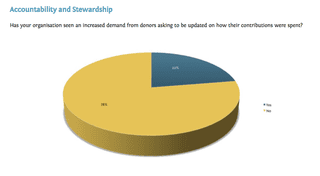How do donors choose which charity to give to?
I've just read a very interesting piece from Beth Breeze in Civil Societylooking at how donors decide which charities to support.
As we've seen in other pieces of research, donors continue to struggle to distinguish one organisation from another.
They feel restricted by the lack of information. This makes it difficult for them to weigh up the differences between charities.
Unable to make the 'best' choice, they fall back on different strategies to help them make the decision as to which ones they should support.
Beth has identified three main approaches:
Taste-based
Supporting a charity that undertakes the work that matters to them. This might be work of high need such as giving after a disaster, but also might include borderline charitable activities such as restoring steam engines.
Personal experience
Beth describes this in terms of people creating 'philanthropic autobiographies' based on their life experiences. It relates support for charities to positive contact. Donors often described favoured organisations as being "near to the heart" or "admired".
Path dependent
Support based on past actions. Few donors disregard past giving behaviour and were seen to make "incremental changes to their portfolio of favoured charities, adding new recipients that fit within pre-existing categories that have already been mentally 'approved'."
These are further influenced by ties of loyalty and the influence of celebrities and authority figures.
But it's the impact of the lack of knowledge that is most revealing. Judgements on charity competence were often based on how little money was spent on staff salaries and on whether overheads were low.
And obviously, given the fact that mailing packs are the main interface, they were often seen as an indicator of general efficiency. Interestingly, Beth found that too few communications is as bad as too many.
Her solution is to give the donor control over what they receive. That's advice which is right on the button.
But few organisations actually ask donors. Those that do get some startling results.
 In any case, the research shows that donors are content to 'muddle through'. This is backed up by Blackbaud's 2009 State of the Not-for-Profit Industry Survey (PDF), which reports that donors don't seem to make any extra demands for feedback on how donations are being spent – only 1 in 5 UK charities have seen any increased interest in more feedback.
In any case, the research shows that donors are content to 'muddle through'. This is backed up by Blackbaud's 2009 State of the Not-for-Profit Industry Survey (PDF), which reports that donors don't seem to make any extra demands for feedback on how donations are being spent – only 1 in 5 UK charities have seen any increased interest in more feedback.
But the fact is, when we show donors what they have helped achieve, we drive significant levels of engagement. Supporters aren't necessarily driven by successful outcomes if they don't feel any ownership.
Bluefrog demonstrated this with our research on mid-value donors back in 2007. Beth's research seems to back this up:
"Donors' prime concern may often be as much about maximising personal satisfaction than seeking the best social outcomes…our findings suggest this outlook is not exclusive to major donors."
The focus for charities must be less on building self-congratulatory brands. Rather than using WE to talk about what the charity has done, the emphasis should be on allowing donors to engage in what they believe in by bringing them as close as possible to the work they have made possible. The wordYOU is far more powerful in this respect.
In developing communication plans, charities would be well advised to take some advice from the pizza restaurant on the right. People don't want to support the best charity in the world, they want to support the charity that is best for them.

You'll find the full research on www.cgap.org.uk soon. Beth will announce the publication on twitter. You can follow her at @UKCPhilanthropy.
Tags In
The Essentials

Crack the Code to Regular Giving: Insights, Strategies, and a Special Giveaway!

‘Tis Halloween. Keep to the light and beware the Four Fundraisers of the Apocalypse!

Why do people give? The Donor Participation Project with Louis Diez.

A guide to fundraising on the back of a postcard

What does the latest research tell us about the state of fundraising?





